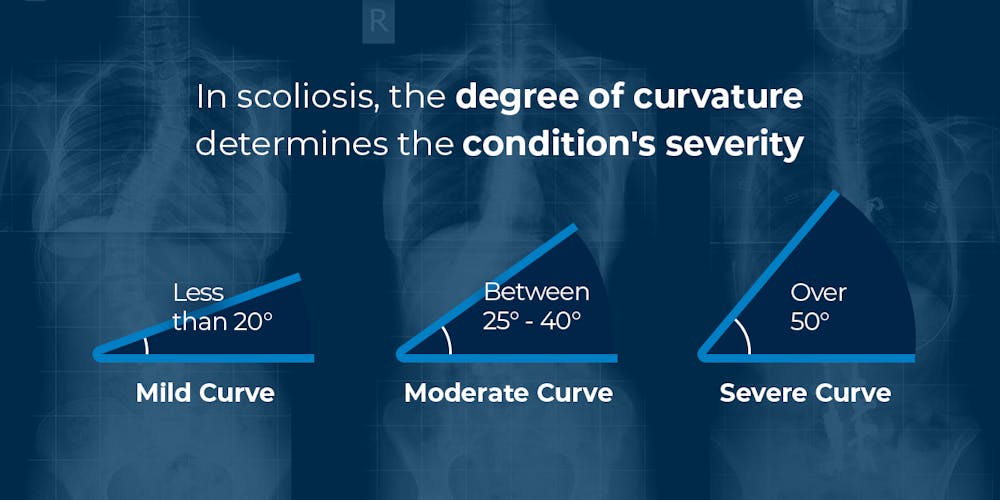
Every time you stand up, sit down or grab an object from the counter or floor, your spine helps you perform each of these tasks. It holds your body together, connects the brain to the rest of your body and allows you to move freely.
A healthy spine naturally has a gentle “s” curve when viewed from the side and is straight when viewed head-on. The spine has four different curves — the lordosis curve, the thoracic kyphosis curve, the lumbar lordosis curve and the sacral kyphosis curve. You can experience pain, mobility constraints and mood changes when the curves in your spine are more exaggerated than they should be.
Your spine health can affect your nervous, digestive, reproductive and respiratory systems. Understanding the normal curve can help you better recognize spine disorders and get the help you need on time.
What Is the Normal Curvature of the Spine?
A normal spine has harmless small curvatures that produce no pain or mobility problems. Larger curves tend to worsen over time and can cause arthritis and other health issues. The spinal curvature is classified by two healthy types:
- Kyphotic curves: The sacral and thoracic spines have kyphotic curves, which are curved outward and toward the spine.
- Lordotic curves: The lumbar and cervical parts of the spine are lordotic curves. They are curved inward and toward the spine.
At New York Spine Institute, our spine specialist, Dr. Timothy Roberts, can help you understand the functions and limitations of this essential support structure.
The Four Types of Spine Curves
A healthy spine has four curves, two of which move toward the back and two of which move away from the back. These curves work together to allow mobility and support. The four different types of correct spine curves are:
- The cervical lordosis curve is at the top of your spine. It goes from your neck to your shoulder blades and helps you maintain posture and absorb movement impact. The normal curvature of the cervical lordosis is 20 to 40 degrees.
- The thoracic kyphosis curve runs behind your chest. This part of the spine is important for standing up straight and achieving balance. A normal curvature for the thoracic kyphosis curve is 20 to 40 degrees.
- The lumbar lordosis is found at the body’s lower back. It pushes your hips and belly slightly forward. The normal curvature of the lower spine is 40 to 60 degrees.
- The sacral kyphosis is near the pelvic area. It starts in the sacrovertebral articulation and ends in the coccyx. The normal curvature for the sacral kyphosis curve is between 20 and 45 degrees.
A proper diagnosis will include testing and comparing the results of a normal neck curve X-ray and spine X-ray to your own results. This will help your doctor provide a correct diagnosis and treatment.
How Much Curve Should Your Back Have?
Everyone has some curve in their spine, but spine disorders like scoliosis, kyphosis and lordosis can exaggerate the curve. If you’re wondering whether the curve in your spine is normal, it’s a good idea to visit your doctor for a diagnosis. For example, in people with scoliosis, the degree of curvature determines the condition’s severity. A mild curve is less than 20 degrees, a moderate curve is between 25 and 40, and a severe curve is over 50 degrees.

Spinal problems and irregular curvatures can develop for different reasons, including osteoporosis, degenerating discs, arthritis, injury, some cancer treatments, obesity and genetics.
To get a proper diagnosis and the care your spine needs, it’s important to contact a trusted and reliable health care specialist if you experience any of these symptoms:
- Back pain: You experience back pain, especially after waking up in the morning or after a nap.
- A gap underneath the lower back: There’s a gap between your back and the surface when you lie down.
- Stiff back: You may feel stiffness in your back throughout the day or at specific moments.
- Mobility problems: Some movements are harder to perform, like reaching for an object or touching your toes.
- Leaning toward one side: You tend to lean toward one side when you sit or stand, and sitting or standing straight causes pain.
- Developing a hump: There’s a noticeable hump in your back, and it may also cause pain.
- An outward curve: There’s a noticeable outward curve above the hip, which makes your glutes and belly stand out.
- Uneven hips: If one hip is higher than the other and looks rounder, your waist will look uneven.
- Uneven spine: The spine curves out more than it should, causing you to lean forward and create a noticeable hump.
- Uneven shoulder blades: A shoulder blade is higher than the other when you look at it from the back.
These symptoms do not necessarily suggest scoliosis, kyphosis, lordosis or any spinal disorder on their own. However, they are worth a visit to a specialist. Dr. Roberts has the skills and experience to evaluate your spine and recommend tests or X-rays.
How to Treat a Spine Curve
Treatment for abnormal spine curvature will depend on the type of condition, the severity of the curve, and how it has affected your quality of life and everyday activities. There are different treatments your doctor might suggest:
- Painkillers: This option can help relieve pain for the patient while the doctor determines a proper treatment route. However, it is not meant to be a permanent solution.
- Exercise: Physical therapy that includes stretches and exercise is great for mild cases, helping alleviate pain and correct posture.
- Braces: This device helps prevent your curve from moving and further damaging your spine.
- Surgery: In some severe cases, surgery will be needed to correct the curvature.
Each patient is different and will require personalized treatment, including one or more of the options above. A specialist can diagnose the condition and define the best course of treatment. Your doctor may request periodic visits to perform X-rays and assess the progression of the curve.
Contact Our Specialist at NYSI if You’re Concerned About Spine Curvature
With proper and timely diagnosis and personalized treatment, you can live a pain-free and active life. If you’ve experienced symptoms, have been diagnosed with a spine disorder, are in pain or are concerned about the curve of your spine, schedule a consultation with our spine and back specialist at New York Spine Institute.
Dr. Timothy T. Roberts, our award-winning orthopedic spine surgeon, has years of experience and specializes in innovative, cutting-edge treatments. He can offer different treatment options that best support your health. His priority is providing his patients with relief and quality of life. Reach out today to learn more about how he can help you or a family member treat spine disorders.

